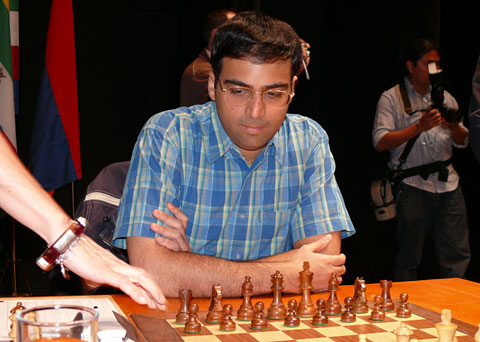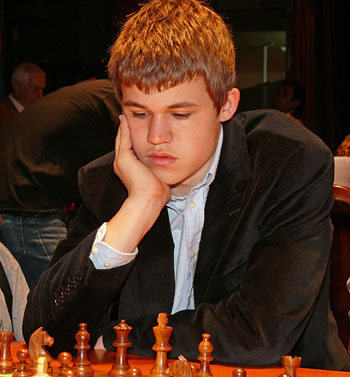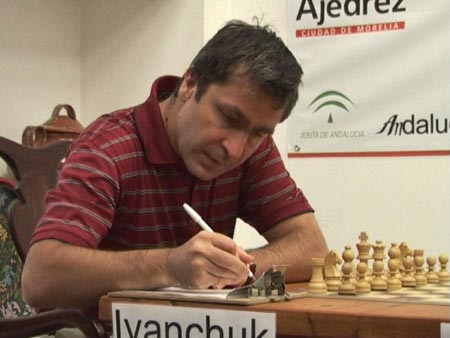| Latest | Greatest | Lobby | Journals | Search | Options | Help | Login |
|
|
|
This topic is archived. |
| Home » Discuss » Topic Forums » Sports |
|
| Jack Rabbit
|
Fri Mar-07-08 09:37 PM Original message |
| The Jack Rabbit Chess Report (March 7): Vishy win Morelia; Fabiano shares lead in Reykjavik |
|
Vishy wins first prize in Morelia-Linares
 Viswanathan Anand of India, the world champion, won the pretigious annual Morelia-Linares International Tournament earlier today in the mining town of Linares, Andaluc�a (Spain). Anand scored 8� points in the event winning 4 and losing one in 14 rounds. He entered today's final round needing only to avoid loss to finish with at least a share of first place. Anand drew his game with former FIDE world champion Veselin Topalov of Bulgaria, and the other three games today also ended in draws. Seventeen-year-old Norwegian grandmaster Magnus Carlsen finished second with 8 points. Magnus actually won more games than Anand (5), but also lost three games. Topalov and Armenia's Levon Aronian tied for third place with 7� points each. Topalov also won 5 games, but lost 4; Aronian won 3 and lost 2. In this year's other top tournament so far, the Corus A Tournament in Wijk aan Zee, Holland, Magnus and Aronian tied for first while Anand and Teimour Radjabov of Azerbaijan tied for third. Radjabov finished in fifth place in Morelia-Linares at 50% with 7 points. In Wijk aan Zee, Topalov finished with a disappointing 6 points out of 13 in a three-way tie for eighth place. The first half of the tournament was played in Morelia, Minoach�n, near the Pacific coast of Mexico. After a four-day recess, the players reconvened in Linares, which is the birthplace of the famous classical guitarist, the late Andr�s Segovia. Fabulous Fabiano tied for lead in Reykjavik Open  Fabiano Caruana, at 15 years of age the Italian national champion, is tied for first place in the Reykjavik Open with Iceland's Hannes Stefansson with 4� points each after five rounds. The native of Miami, Florida, who holds dual citizenship with Italy and the United States, won his game today with Black against Stefan Kristjansson of Iceland in just 30 moves. Six player are tied for third place with 4 points each, including reigning world junior champion Ahmed Adly of Egypt and top seed Wang Yue of China, who was upset in the first by tournament organizer and FM Bjorn Thorfinnsson of Iceland. Upon defeating Wang Yue, who is China's highest ranked player with an Elo score of 2698, Bjorn, who is rated 2364, said that he would endeavor "not to humiliate myself and Wang Yue by playing like the patzer I truly am." Several women got off to quick starts winning their first three games. They were Inna Gaponenko of Ukraine, Germany's Elisabeth P�htz and the reigning women's champion of India, 21-year-old Tania Sachdev. Ms. Gaponenko is currently tied for ninth with 3� points. |
| Printer Friendly | Permalink | | Top |
| Jack Rabbit
|
Fri Mar-07-08 09:41 PM Response to Original message |
| 1. Games from Linares |
|
Diagrams on the Jack Rabbit Chess Report are made with Chess M�rida, a true type font that can be downlaoded free here. !""""""""# $tMvWlVmT% $OoOoOoOo% $ + + + +% $+ + + + % $ + + + +% $+ + + + % $pPpPpPpP% $RnBqKbNr% /(((((((() WHITE White to move (This position is a theoretical draw) |
| Printer Friendly | Permalink | | Top |
| Jack Rabbit
|
Fri Mar-07-08 09:46 PM Response to Reply #1 |
| 3. Anand - Shirov, Round 8 |
 Vishy Anand Vishy Anand - Alexey Shirov Morelia-Linares International Tournament, Round 8 Linares, Andaluc�a (Spain), 28 February 2008 Open Sicilian Game: Sveshnikov Defense 1.e4 c5 2.Nf3 Nc6 3.d4 cxd4 4.Nxd4 Nf6 5.Nc3 e5 6.Ndb5 d6 7.Bg5
7...a6 8.Na3 b5 9.Nd5
9...Be7 10.Bxf6 Bxf6 11.c3 Bg5
12.Nc2 0-0
13.a4 bxa4
14.Rxa4 a5 15.Bc4 Rb8 16.b3 Kh8 17.Nce3
17...g6 !""""""""# $ TvW T L% $+ + +o+o% $ +mO +o+% $O +nO V % $r+b+p+ +% $+pP N + % $ + + PpP% $+ +qK +r% /(((((((() WHITE: Vishy Anand Position after 17...g7g6 18.Qe2!?
18...f5
19.h4 Bxe3 20.Qxe3 fxe4 21.h5 g5
22.Qxe4 Bb7
23.Qe3
23...e4?
24.0-0 Ne5
!""""""""# $ T W T L% $+v+ + +o% $ + O + +% $O +nM Op% $r+b+o+ +% $+pP Q + % $ + + Pp+% $+ + +rK % /(((((((() WHITE: Vishy Anand Position after 24...Nc6e5 25.Rfa1!
25...Qe8
26.Rxa5
26...Qxh5 27.Qxe4 Rbe8
28.Be2 Qh4
29.Qxh4 gxh4 30.Ne3 h3 31.gxh3 Nf3+
32.Bxf3 Rxf3 33.Rh5 Rg8+
34.Kf1 Rgf8 35.Nd1 Rd3
36.Rh4 Bf3
37.Rd4 Rxd4 38.cxd4 Rf4
39.Ne3 Rxd4 40.Ra4 Rd3
41.Rf4 Bh5
42.b4 d5 43.Kg2
43...Bg6 44.Nf5 Kg8
45.Ne7+ Kg7 46.Nxg6 Kxg6 47.Rf3 Rd1
!""""""""# $ + + + +% $+ + + +o% $ + + +l+% $+ +o+ + % $ P + + +% $+ + +r+p% $ + + Pk+% $+ +t+ + % /(((((((() WHITE: Vishy Anand Position after 47...Rd3d1 48.Rb3!
48...d4 49.Kf3 d3 50.Ke3 Rh1
51.b5!
51...Rxh3+ 52.f3 Rh1
53.b6 Re1+ 54.Kxd3 Re8 55.b7 Rb8 56.Ke4 1-0
|
| Printer Friendly | Permalink | | Top |
| Jack Rabbit
|
Fri Mar-07-08 09:53 PM Response to Reply #1 |
| 4. Ivanchuk - Carlsen, Round 8 |
 Magnus Carlsen Vassily Ivanchuk - Magnus Carlsen Morelia-Linares International Tournament Round 8 Linares, Andaluc�a (Spain), 28 February 2008 Spanish Petit Royal Game: Gothic Defense (Berlin Defense) 1.e4 e5 2.Nf3 Nc6 3.Bb5 Nf6 4.0-0 Nxe4 5.d4 a6
6.Bxc6
6...dxc6 7.Qe2 Bf5 8.Re1
8...Bb4!?
9.c3
9...Bd6 10.Qc2 Qd7
11.dxe5 Bc5
12.Rxe4 0-0-0!?
13.Nbd2 Qd5 14.Kf1 Rhe8
15.b3?
15...g5 16.Bb2
16...g4 17.Nd4 Bxd4 18.cxd4 !""""""""# $ +lTt+ +% $+oO +o+o% $o+o+ + +% $+ +wPv+ % $ + Pr+o+% $+p+ + + % $pBqN PpP% $R + +k+ % /(((((((() WHITE: Vassily Ivanchuk Position after 18.cd4:B 18...c5!
19.Rae1
19...cxd4 20.Qc4
20...Bxe4!
21.Rxe4
21...Rxe5!
22.Rxg4 Rde8 23.Nf3
!""""""""# $ +l+t+ +% $+oO +o+o% $o+ + + +% $+ +wT + % $ +qO +r+% $+p+ +n+ % $pB + PpP% $+ + +k+ % /(((((((() WHITE: Vassily Ivanchuk Position after 23.Nd2f3 23...Qxc4+!
24.bxc4 Re2 25.Bxd4 Rxa2 26.Rg7 a5
27.Rxf7 Rc2 28.g4 a4 29.g5 a3 30.Rxh7 a2
31.Rh8 Rxh8 32.Bxh8 Rxc4 33.h3
33...c5 34.Ne1
!""""""""# $ +l+ + B% $+o+ + + % $ + + + +% $+ O + P % $ +t+ + +% $+ + + +p% $o+ + P +% $+ + Nk+ % /(((((((() WHITE: Vassily Ivanchuk Position after 34.Nf3e1 34...Rc1!
35.g6 Kd7 36.Bb2
36...Ke6 37.h4 c4 38.h5
38...c3 39.Bxc1 a1Q 40.Nd3 0-1
|
| Printer Friendly | Permalink | | Top |
| Jack Rabbit
|
Fri Mar-07-08 09:56 PM Response to Reply #1 |
| 5. Leko - Ivanchuk, Round 9 |
 Vassily Ivanchuk Morelia-Linares International Tournament, Round 9 Linares, Andaluc�a (Spain), 29 February 2008 Open German Game: Seirawan Opening 1.e4 c6 2.d4 d5 3.Nc3 dxe4 4.Nxe4 Bf5 5.Ng3 Bg6 6.h4 h6 7.Nf3 Nd7 8.h5
8...Bh7 9.Bd3 Bxd3 10.Qxd3 e6 11.Bf4 Qa5+
12.Bd2 Bb4
13.c3 Be7 14.c4 Qc7
15.0-0-0 Ngf6 16.Kb1 0-0 17.Rhe1 !""""""""# $t+ + Tl+% $OoWmVoO % $ +o+oM O% $+ + + +p% $ +pP + +% $+ +q+nN % $pP B Pp+% $+k+rR + % /(((((((() WHITE: Peter Leko Position after 17.Rh1e1 17...a5!?
18.Bc1
18...Rfd8 19.Qc2 a4 20.Ne5
20...Nxe5 21.dxe5 Rxd1 22.Qxd1 Nd7 23.f4
23...Nc5 24.Ne4 Rd8 25.Qc2
25...Nxe4
26.Rxe4 Qb6 27.Qxa4?
27...Qg1
28.Qc2 Rd1
29.Re2
29...Rf1 30.a3
30...Bc5 31.Qd2
!""""""""# $ + + +l+% $+o+ +oO % $ +o+o+ O% $+ V P +p% $ +p+ P +% $P + + + % $ P Qr+p+% $+kB +tW % /(((((((() WHITE: Peter Leko Position after 31.Qc2d2 31...Rd1!
32.Qc2 Bd4 33.c5
33...Rf1 34.Rd2
34...Rxf4 35.Ka2
35...Rf2 36.Rxf2 Bxf2 37.g4
37...Bxc5 38.Bf4
38...Qd4 39.Qd2 Qe4 40.Ka1 Bd4 41.Qh2
41...c5 42.Ka2 b5 43.Qd2
43...Qd5+ 44.Kb1 b4 45.a4
45...b3 46.Qd3 c4 47.Qe2 Qh1+ 48.Bc1 Qa8 0-1
|
| Printer Friendly | Permalink | | Top |
| Jack Rabbit
|
Fri Mar-07-08 10:06 PM Response to Reply #1 |
| 7. Leko - Carlsen, Round 11 |
 Peter Leko Morelia-Linares International Tournament, Round 11 Linares, Andaluc�a (Spain), 03 March 2008 Open Sicilian Game: Sveshnikov Defense 1.e4 c5 2.Nf3 Nc6 3.d4 cxd4 4.Nxd4 Nf6 5.Nc3 e5 6.Ndb5 d6 7.Bg5 a6 8.Na3 b5 9.Nd5 Be7 10.Bxf6 Bxf6 11.c3 Bg5 12.Nc2 Ne7
13.h4
13...Bh6 14.a4 bxa4 15.Ncb4 0-0 16.Qxa4
16...Nxd5 17.Nxd5 a5 18.Bb5 Be6
19.Bc6 Rb8 20.b4 Bxd5 21.Bxd5 axb4 22.cxb4 Qb6 23.Rb1
23...Kh8!?
24.0-0
24...f5
25.Qa5
25...fxe4 26.Qxb6 Rxb6 27.Rb3 Rc8 28.Ra1 g6 29.Ra8
29...Rxa8 30.Bxa8 Bf8
31.b5
31...Be7 32.g3 Bd8 33.Bxe4 d5?
!""""""""# $ + V + L% $+ + + +o% $ T + +o+% $+p+oO + % $ + +b+ P% $+r+ + P % $ + + P +% $+ + + K % /(((((((() WHITE: Peter Leko Position after 33...d6d5 34.Bxd5
34...Rd6
35.Bc6 Bb6 36.Rb2 Rd3 37.Kg2 Kg7 38.Be4
38...Ra3 39.g4
39...Bd4
40.Rc2 Rb3 41.Rc7+ Kh8
42.Rc8+ Kg7 43.Rc7+ Kh8 44.Rb7 Rb2 45.h5
45...Rxf2+ 46.Kg3 Rf4 !""""""""# $ + + + L% $+r+ + +o% $ + + +o+% $+p+ O +p% $ + VbTp+% $+ + + K % $ + + + +% $+ + + + % /(((((((() WHITE: Peter Leko Position after 46...Rf2f4 47.h6
47...Rf8 48.Rc7
48...Bf2+ 49.Kg2 Be3 50.g5?!
50...Rb8 51.Rc3?!
51...Bd4 52.Rc6?
52...Kg8?
!""""""""# $ T + +l+% $+ + + +o% $ +r+ +oP% $+p+ O P % $ + Vb+ +% $+ + + + % $ + + +k+% $+ + + + % /(((((((() WHITE: Peter Leko Position after 52...Kh8g8 53.Bd5+!
53...Kf8
54.Bc4!
54...Ke7
55.Rc7+ Kd6 56.Rxh7 e4 57.Rg7 Kc5
58.Rc7+ Kd6 59.Rc6+ Ke5 60.Rxg6 Kf5
61.Rd6 Be3 62.h7 1-0
|
| Printer Friendly | Permalink | | Top |
| Jack Rabbit
|
Fri Mar-07-08 09:42 PM Response to Original message |
| 2. Games from Reykjavik |
|
Edited on Fri Mar-07-08 09:42 PM by Jack Rabbit
Diagrams on the Jack Rabbit Chess Report are made with Chess M�rida, a true type font that can be downlaoded free here. !""""""""# $tMvWlVmT% $OoOoOoOo% $ + + + +% $+ + + + % $ + + + +% $+ + + + % $pPpPpPpP% $RnBqKbNr% /(((((((() WHITE White to move (This position is a theoretical draw) |
| Printer Friendly | Permalink | | Top |
| Jack Rabbit
|
Fri Mar-07-08 10:08 PM Response to Reply #2 |
| 8. Thorfinnsson - Wang Yue, Round 1 |
 Bjorn Thorfinnsson To view this game:
Bjorn Thorfinnsson - Wang Yue Open Tournament, Round 1 Reykjavik, 3 March 2008 West India Game: King's Indian Defense 1.d4 Nf6 2.c4 g6 3.Nc3 Bg7 4.e4 d6 5.Nf3 Bg4
6.Be2 Nfd7 7.0-0 0-0
8.Be3 a6!?
9.Qd2
9...e5 10.dxe5
10...dxe5 11.Bg5 Qc8 12.Nd5 Nc6
13.Nd4 exd4 14.Bxg4 f5 15.exf5
15...gxf5?
!""""""""# $t+w+ Tl+% $+oOm+ Vo% $o+m+ + +% $+ +n+oB % $ +pO +b+% $+ + + + % $pP Q PpP% $R + +rK % /(((((((() WHITE: Bjorn Thorfinnsson Position after 15...gf5:p 16.Bh5!!
16...Kh8
17.Ne7 Qb8
18.Nxc6 bxc6 19.Be7 Ne5
20.Bxf8 Qxf8 21.b3 f4 22.Bf3 Qf5
23.Rae1 Rd8 24.Be4 Qf6
25.f3
25...c5 26.Bb1 Bf8
27.Re4 Bd6 28.Qxf4 Qxf4 29.Rxf4 Nxc4 30.Rh4 Ne3
!""""""""# $ + T + L% $+ o + +o% $o+ V + +% $+ O + + % $ + O + R% $+p+ Mp+ % $p+ + +pP% $+b+ +rK % /(((((((() WHITE: Bjorn Thorfinnsson Position after 30...Nd5e3 31.Bxh7?!
31...Nxf1 32.Bd3+ Kg7 33.Kxf1 a5
34.a4
34...Re8 35.Re4?
35...Rh8?
!""""""""# $ + +t+ +% $+ O + L % $ + V + +% $O O + + % $p+ Or+ +% $+p+b+p+ % $ + + +pP% $+ + +k+ % /(((((((() WHITE: Bjorn Thorfinnsson Position after 35...Re8h8 36.h4!
36...Kh6 37.Kf2 Kh5
38.Bb5 Rf8 39.g3 Rg8 40.f4 Rb8
41.Re8
41...Rb6 42.Kf3 Kg6
43.g4 Kf7 44.Re2 Rb8
45.g5 d3 46.Rd2 Rf8 47.Kg4 Ke6
48.f5+ Ke5 49.f6 1-0
|
| Printer Friendly | Permalink | | Top |
| Jack Rabbit
|
Fri Mar-07-08 10:25 PM Response to Reply #2 |
| 9. Jankovic - Tania, Round 2 |
 Tania Sachdev To view this game with a PGN viewer:
Alojzije Jankovic - Tania Sachdev Open Tournament, Round 2 Reykjavik, 4 March 2008 East India Game: Queen's Indian Defense (Kasparov-Petrosian Opening) 1.d4 Nf6 2.c4 e6 3.Nf3 b6 4.Nc3
4...Bb7 5.a3
5...d5 6.cxd5 Nxd5
7.Qc2
7...Be7
8.e4
8...Nxc3 9.bxc3 c5
10.Bb5+ Bc6 11.Bd3 0-0 12.0-0 Bb7!?
13.Bf4
13...Qc8
14.Qe2 Ba6 15.Rfd1
15...Bxd3 16.Rxd3 Nd7
17.h4 Re8 18.h5!?
18...Qa6 19.h6?!
!""""""""# $t+ +t+l+% $O +mVoOo% $wO +o+ P% $+ O + + % $ + PpB +% $P Pr+n+ % $ + +qPp+% $R + + K % /(((((((() WHITE: Alojzije Jankovic Position after 19.h5h6 19...g6!
20.e5
20...cxd4!
21.cxd4 Rac8 22.Qe3 b5 23.Bg5 Bf8
24.d5 exd5 25.Rxd5 Nb6 26.Rdd1
26...Qb7
27.Rd3?!
27...Rc4!
28.Rad1 Re4 29.Qc1 Rg4!?
30.Bf6
30...Nd7
31.Kf1?
!""""""""# $ + +tVl+% $Ow+m+o+o% $ + + BoP% $+o+ P + % $ + + +t+% $P +r+n+ % $ + + Pp+% $+ Qr+k+ % /(((((((() WHITE: Alojzije Jankovic Position after 31.Kg1f1 31...Nxf6!
32.exf6 Qb6 33.Qb2
33...Rf4 34.Rb3 a6 35.g3 Rxf6 36.Nh2 Qc6!
37.Kg1 Rfe6 38.Qd2
38...Re2 39.Qd5 Qxd5 40.Rxd5 Bxh6
!""""""""# $ + +t+l+% $+ + +o+o% $o+ + +oV% $+o+r+ + % $ + + + +% $Pr+ + P % $ + +tP N% $+ + + K % /(((((((() WHITE: Alojzije Jankovic Position after 40...Bf8h6:p 41.a4
41...bxa4 42.Ra3 R8e4 43.Ra5 Bf8
44.R3xa4 Rxa4 45.Rxa4 Bc5 46.Ng4 Re6 47.Rc4 Bb6 48.Kf1
48...h5 49.Nh2 Rf6 50.f4 g5 51.Kg2 g4
52.Nf1 Re6 53.Rc2 Kg7 54.Rb2 a5 55.Nd2
55...Re2+ 56.Kf1 Rf2+ 57.Ke1 Be3 58.Rb3 Rxd2
59.Rxe3 Rd6 60.Ra3 Ra6 61.Ra4 Kg6 62.Ke2
62...h4 63.gxh4 Kh5 0-1
|
| Printer Friendly | Permalink | | Top |
| Jack Rabbit
|
Fri Mar-07-08 10:04 PM Response to Original message |
| 6. . |
|
Edited on Fri Mar-07-08 10:36 PM by Jack Rabbit
:shrug:
|
| Printer Friendly | Permalink | | Top |
| DU
AdBot (1000+ posts) |
Fri May 03rd 2024, 12:25 AM Response to Original message |
| Advertisements [?] |
| Top |
| Home » Discuss » Topic Forums » Sports |
|
Powered by DCForum+ Version 1.1 Copyright 1997-2002 DCScripts.com
Software has been extensively modified by the DU administrators
Important Notices: By participating on this discussion board, visitors agree to abide by the rules outlined on our Rules page. Messages posted on the Democratic Underground Discussion Forums are the opinions of the individuals who post them, and do not necessarily represent the opinions of Democratic Underground, LLC.
Home | Discussion Forums | Journals | Store | Donate
About DU | Contact Us | Privacy Policy
Got a message for Democratic Underground? Click here to send us a message.
© 2001 - 2011 Democratic Underground, LLC